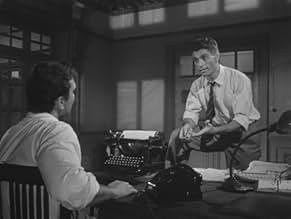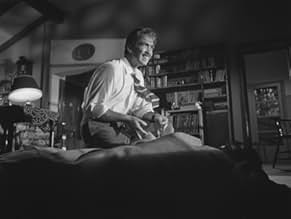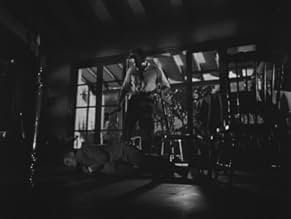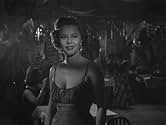Ein Mann, der das perfekte Verbrechen geplant hat, verspürt Reue. Der Protagonist, ein Journalist, unterbreitet ein geschäftliches Angebot, das schnelles Geld verspricht, indem Personen auf ... Alles lesenEin Mann, der das perfekte Verbrechen geplant hat, verspürt Reue. Der Protagonist, ein Journalist, unterbreitet ein geschäftliches Angebot, das schnelles Geld verspricht, indem Personen auf dem Postweg betrogen werden. Zuerst scheint alles wie geplant zu laufen, doch dann beginne... Alles lesenEin Mann, der das perfekte Verbrechen geplant hat, verspürt Reue. Der Protagonist, ein Journalist, unterbreitet ein geschäftliches Angebot, das schnelles Geld verspricht, indem Personen auf dem Postweg betrogen werden. Zuerst scheint alles wie geplant zu laufen, doch dann beginnen die Verdächtigungen.
- Regie
- Drehbuch
- Hauptbesetzung
- Auszeichnungen
- 2 wins total
- Noriega
- (as Otto Weber)
- Hombre en redacción
- (as Jorge Hilton)
Empfohlene Bewertungen
Thanks to the Film Noir Foundation and UCLA, the restored version aired on TCM's Noir Alley hosted by Eddie Mueller. If you can catch his intro and outro, you'll learn some interesting things, such as the original novel was awarded a very prestigious Argentinian award as was the film itself, the score is by one of Argentina's most celebrated composers, and one of South America's most popular, if not most popular, female actors of the time has a small but important role.
There's all kinds of noir style going on, but there's also echoes of Edgar Allan Poe's use of concise storytelling, paranoia, and the concept of justice as an archetype. The acting is wonderful, and the cinematography is stunning. The musical score is all over the place, but it honestly works.
A must for noir junkies.
I loved the look and feel of this Argentinian noir, with its flashbacks, surreal dream sequences, and segues into the inner thoughts of its main character. Instead of a femme fatale we get a tragic figure (Aída Luz), and instead of everything coming apart because of a con game, we get drama out of misunderstanding and paranoia. These are basically good people, driven to dark places by economic desperation, with the post-war conditions in Europe looming as a distant backdrop. I wasn't completely sure about the ending, as the digging wouldn't have to be too deep and the guy should have known it (being vague here on purpose), but I loved how brutally grim it was. Overall, a very satisfying film.
The acting in the movie is outstanding, and we are treated to a film score by the great Argentinian composer Astor Piazzolla.
We saw this movie at the wonderful Dryden Theatre at the George Eastman Museum in Rochester. Congratulations to the Dryden for screening this film in its original 35mm format. Los tallos amargos was considered lost until a 35mm negative was found and restored by the UCLA Film & Television Archive.
This movie might not be for everyone, but if you love film noir, this is the movie for you.
The story is quite interesting. It could have been superbly interesting if the script could have been fully developed going deeply into the main character psychology and motives for his behavior instead of the bumpy way shown here so abruptly from one scene to the next (unless I saw a faulty copy with missing scenes).
Our tortured main character motivations for what he does, as seen in this version, is totally incomprehensible, since he has no real proof to take such a drastic measure to solve the dilemma that tortures his feverish mind.
The photography may be the best asset in this film, done in black and white with a very impressive atmosphere, dark and oppressive almost all the time.
The soundtrack is also very good, following the black mood of the story very precisely and to the point.
But the whole feeling disclosed here, either about the city, its people or our protagonists is nowadays as removed from us as a Christopher Columbus ship could be as incongruous standing next to an atomic submarine.
Wusstest du schon
- WissenswertesAs discussed on TCM's Noir Alley by host Eddie Muller in July 2021, a screening of the restored 35mm print of this film was held on behalf of the Film Noir Foundation at the Museum of Modern Art (MoMA) in New York City in February 2016, and shockingly in attendance was 90 year-old Vassili Lambrinos, who, after years of living in various parts of the globe, was living just a few blocks from MoMA. Lambrinos had never seen the film on the big screen nor with an audience before that screening, having seen the film only in an editing room before then.
- Zitate
Andreani: You make him infallible. You have an old passion; the need to obey.
Alfredo Gaspar: Passion to obey?
Andreani: To be a subordinate.
- VerbindungenReferenced in Preserving Memory: Fernando Martín Peña on Argentine Cinema (2024)
Top-Auswahl
Details
- Erscheinungsdatum
- Herkunftsland
- Sprache
- Auch bekannt als
- The Bitter Stems
- Drehorte
- Plaza de Mayo, Buenos Aires, Argentinien(Gasper and Jarvis walk in the Plaza de Mayo and look at the Cabildo.)
- Produktionsfirma
- Weitere beteiligte Unternehmen bei IMDbPro anzeigen
- Laufzeit1 Stunde 30 Minuten
- Farbe
- Sound-Mix
- Seitenverhältnis
- 1.37 : 1
Zu dieser Seite beitragen





























